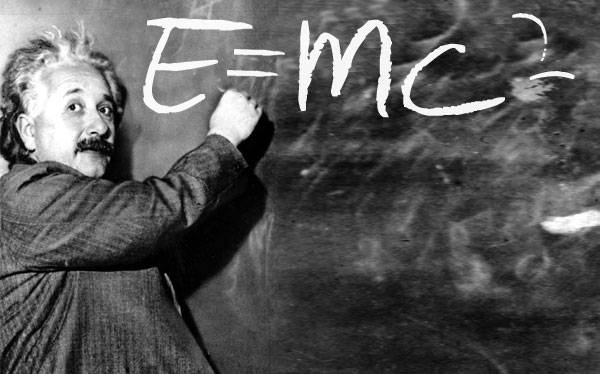E=mc2
E=mc2
We are now ready to take on E=mc2. With relativistic momentum, relativistic velocity addition and relativistic kinetic energy as our tools, we will be able to argue that mass and energy are somehow related.
We need start by analysing a collision.
2 Particles of the same mass come together at speed v and stick together. In this system no energy is lost to sound, heat etc.... All the kinetic energy of the incoming particles stays in the system. We will argue that the kinetic energy of the two particles will go into increasing the total mass of the system.And if we think generally we get the equation
E = γmc2
So we have our final equation. The famous equation we know is a special case for stationary objects where γ = 1
E = mc2
For people who use the outdated concept of relativistic mass. E = mc2 is written where m is relativistic mass. The correct equation - E = γmc2, shows that as the velocity of an object increases, γ increases and so its energy increases. The one which uses relativistic mass, suggests that the mass of the object is changing and that this is causing an increase in energy.
Another thing to note is that this equation only holds for objects moving below the speed of light and for objects with mass.
There is another equation which holds for photons as well which was derived by Paul Dirac.
It is E2 = (pc)2 + (mc2)2.
What Does It Mean?
A lot of people think that it means mass can be converted into energy and mass is a locked up version of energy. This is not the case.What is Mass
You have to realise that the mass of an object is not just the sum of the masses of its parts. The way those parts move also affects its mass. An object with parts that have a lot of energy, will have more mass than one with low energy parts. A broken clock that has no moving cogs has less mass than a working one that has cogs with kinetic energy. The mass of the working clock is the mass of all its parts + its kinetic, potential and thermal energy divided by the speed of light squared. This number is tiny and so this extra mass is negligible in our lives.This does not mean the mass of a moving object is greater than one that is stationary.
The individual moving cogs are not heavier than the individual stationary cogs. When we look at the system as a whole however, we can say that the clock with moving cogs has more mass than the clock with stationary cogs. The key is we are looking at a stationary system as a whole.
Another Example
A fully charged phone has more potential energy than a drained one and so a fully charged phone is heavier than a dead one. The phone never converts mass into energy. Before the phone had been used there was simply more potential energy in it manifesting as part of the mass of the phone. The extra mass is obtained by the potential energy divided by the speed of light squared. This number is tiny and so we do not notice that drained phones are lighter than charged phonesIt turns out that scales weigh the energy of the particles of objects we just never noticed it.
Why Do Atoms Have Weird Masses?
This is why atoms on the periodic table weigh less than their individual protons, neutrons and electrons added up. In this case, the mass of an atom is the mass of its parts + its energy where the energy is negative. This is because potential energies can be negative and when electrons are near the nucleus of an atom, the negative potential energy is greater than the kinetic energy of the electron in orbit.Fundamental Particles
We can go even further and look at protons and neutrons. Where do their masses come from? They are made of quarks. The mass of protons and neutrons is given by the sum of the mass of the quarks + quark potential energy (gluons).
What about electrons and quarks? In the Standard Model these can not be broken down further. You can still think of these as energies however.
There is the higgs field that quarks and electrons interact with giving them potential energy. There is also the electric field produced by electrons which electrons interact with and there is the gluon field produced by quarks which quarks interact with. With this view we never have to use mass to energy conversion. Mass is simply an indicator of the amount of energy an object has. This is what we measure when we use a scale, we just haven't realized it. Below is a great video explaining this concept that mass is energy.
The real point to take away is that the whole time we have been measuring mass, we have actually been measuring the energies of objects. Mass is just the sum of the kinetic and potential energies that make up a object. Any object can be thought of as the sum of its parts + some energy. The parts can then be thought of as the sum of some other parts + some energy. This can continue forever until you reach the gluon field, electric field and higgs field. This way mass is never "converted" into energy.
Check out my other posts on special relativity! (Link to all the posts)
How To Travel To The Future
How Galilean Relativity And The Lorenz Maxwell Equations (The 2 Postulates) Contradict
The Postulates Of Special Relativity




Thanks.
ReplyDelete